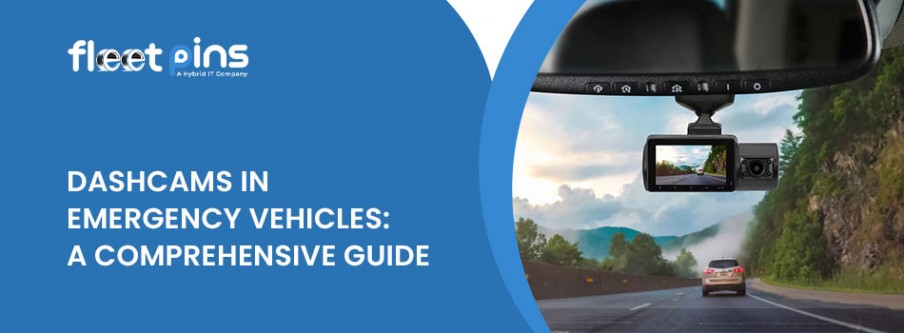
- On 2024-08-13
Dashcams in Emergency Vehicles: A Comprehensive Guide
Whether it's an ambulance rushing to a hospital or a fire truck heading to a burning building, the actions taken by emergency responders are critical. However, these high-pressure situations can also be chaotic and prone to accidents. This is where dashcams come into play. Dashcams, or dashboard cameras, have become essential tools in enhancing safety, providing accountability, and improving the overall efficiency of emergency service fleets. Let's explore why ambulances have dash cameras.
Why Equip Emergency Vehicles with Dashcams?
Equipping your emergency service fleet with dash cams is not just a modern trend. Emergency vehicle trackers are a necessity. Emergency vehicle dash cameras serve multiple purposes that are critical for the safety and efficiency of emergency responders.
Evidence Collection for Incident Analysis
Dashcams provide real-time recording of events as they unfold. In the case of an accident or incident involving an emergency vehicle, the footage can be used as concrete evidence to determine the cause. This is particularly important in legal situations where the actions of the emergency responders might be questioned. The footage can clarify what happened, forgiving the drivers if they were not at fault or providing valuable information to prevent future incidents.
Accountability Among Emergency Vehicle Drivers
Having a dashcam in place encourages accountability among emergency vehicle drivers. Knowing their actions are being recorded, drivers are more likely to adhere to safety protocols and drive responsibly, even under pressure. This ensures that all fleet members are following best practices, which ultimately reduces the risk of accidents.
Training and Skill Improvement
Recorded footage from dashcams can be used as a training tool for emergency responders. Reviewing real-life scenarios allows recruits to learn from past incidents and helps experienced drivers improve their response to various situations. It's an invaluable resource for continuous improvement and can lead to better decision-making in the field.
Enhancing Public Trust in Emergency Services
The presence of dashcams in emergency vehicles enhances public trust. It reassures the public that emergency services are committed to transparency and accountability. This can lead to better community relations, as citizens are more likely to support and trust a fleet that prioritizes safety and transparency.
Reducing Insurance Costs
Insurance claims involving emergency vehicles can be costly. Dashcam footage can help reduce these costs by providing clear evidence in the case of an accident. Insurers may offer discounts for fleets equipped with dashcams, recognizing that these devices reduce the likelihood of fraudulent claims and improve overall safety.
You May Also Read: How Dashcams Enhance Driving Safety and Security | Complete Guide
How to Choose the Right Dashcam for Emergency Vehicles
Selecting the right emergency vehicle tracker requires careful consideration of several factors. The unique needs of emergency services mean that not all dashcams are suitable. Here's what to consider:
High-Definition Recording for Clarity
The clarity of the footage is crucial. Emergency vehicles operate in various lighting conditions, from the bright light of day to the dark of night. A dashcam with high-definition recording capabilities captures every detail clearly, regardless of the time of day or weather conditions. Look for dashcams that offer at least 1080p resolution.
Wide-Angle Lens for Maximum Coverage
Emergency vehicles often navigate through busy streets and tight spaces. A dashcam with a wide-angle lens can capture a broader field of view, ensuring that all critical details, including side events and cross-traffic, are recorded. This is particularly important in densely populated urban areas where incidents can happen from any direction.
Night Vision and Low-Light Performance
Many emergency calls happen at night, making night vision a critical feature for dashcams in emergency vehicles. Dashcams with advanced low-light performance or infrared capabilities can capture clear footage even in the darkest conditions, ensuring no detail is lost during nighttime operations.
Durability and Reliability in Harsh Conditions
Emergency vehicles are often exposed to harsh conditions, including extreme temperatures, vibrations, and rough handling. The dashcam you choose should be durable enough to withstand these conditions. Look for models built with rugged materials and rated for reliability in extreme environments.
GPS and Speed Tracking for Contextual Data
GPS functionality is essential for emergency vehicles. Dashcams equipped with GPS can record the vehicle's speed and location, providing additional context to the footage. This can be crucial in assessing the situation during an incident and verifying that the vehicle was following the correct route or speed.
Cloud Storage and Remote Access for Real-Time Monitoring
In high-stakes situations, immediate access to footage can be critical. Dashcams with cloud storage capabilities allow for real-time footage upload, which can be accessed remotely by supervisors or dispatchers. This feature ensures that important footage is never lost and can be reviewed as needed, even from a remote location.
You May Also Read: Why You Should Invest in a Dash Camera
Step-by-Step Guide to Installing Dashcams in Emergency Vehicles
Installing dashcams in emergency vehicles requires careful planning to ensure they are practical and unobtrusive. Here's a step-by-step guide to installing dashcams in your fleet:
Choose the Optimal Mounting Location
The dashcam should be mounted in a position that offers a clear view of the road ahead without obstructing the driver's view. Typically, the best place is behind the rearview mirror. Ensure the camera is centered and positioned to capture the entire field of view.
Proper Wiring and Power Supply
Emergency vehicles often have complex electrical systems due to the various equipment they carry. It's essential to wire the dashcam correctly to avoid interference. The dash cam should be connected to a constant power source to ensure it starts recording as soon as the vehicle is turned on. Sometimes, you can connect the dashcam to a secondary power source to keep it recording even when the vehicle is off.
Proper Wiring and Power Supply
Loose wires can be a hazard, especially in emergency vehicles where quick movements are made every day. Use zip ties or adhesive clips to secure the wiring along the windshield's edges and down to the power source. This will keep the installation tidy and prevent interference with other vehicle functions.
Test the Installation for Functionality
- Before finalizing the installation, test the dashcam to ensure it is recording correctly.
- Check the angle, clarity, and functionality of the camera.
- Ensure that the dashcam's features, such as GPS tracking and cloud upload, work as expected.
Regular Maintenance for Longevity
Once installed, the dashcams must be maintained regularly. This includes checking for loose wiring, ensuring the lens is clean, and verifying that the software is up to date. Regular maintenance ensures that the dashcam continues optimally, providing reliable footage when needed.
You May Also Read: Top Mistakes to Avoid When Installing Your Dashcam
Fleet Pins AI Standalone Safetycam: An Advanced Solution for Emergency Vehicles
Fleet Pins offer an AI Standalone Safetycam that enhances driver and fleet safety with input from fleet managers. Meanwhile, Fleet Pins GPS HD SafetyCam integrates solutions to reduce risk, coach drivers, and improve safety. Here's what fleet Pins Dash Cams set apart:
- AI-Driven Incident Detection
- Real-Time Monitoring and Alerts
- Driver Behavior Analysis
- Seamless Integration with Existing Systems
Emergency services don't need to overhaul their systems to benefit from this advanced technology. The SafetyCam can be added to the existing infrastructure, providing enhanced functionality without disruption.
Conclusion
Dashcams have become an essential tool in the operation of emergency vehicles. These have become necessary by providing crucial benefits such as enhanced safety, accountability, and operational efficiency. Emergency service fleets can significantly improve their performance and safety by carefully selecting the right dashcam, ensuring proper installation, and leveraging advanced technologies like the Fleet Pins AI SafetyCam. As technology advances, dashcams' role in emergency vehicles will only become more critical. It's a continuous essential tool to save lives and protect those who protect us.




